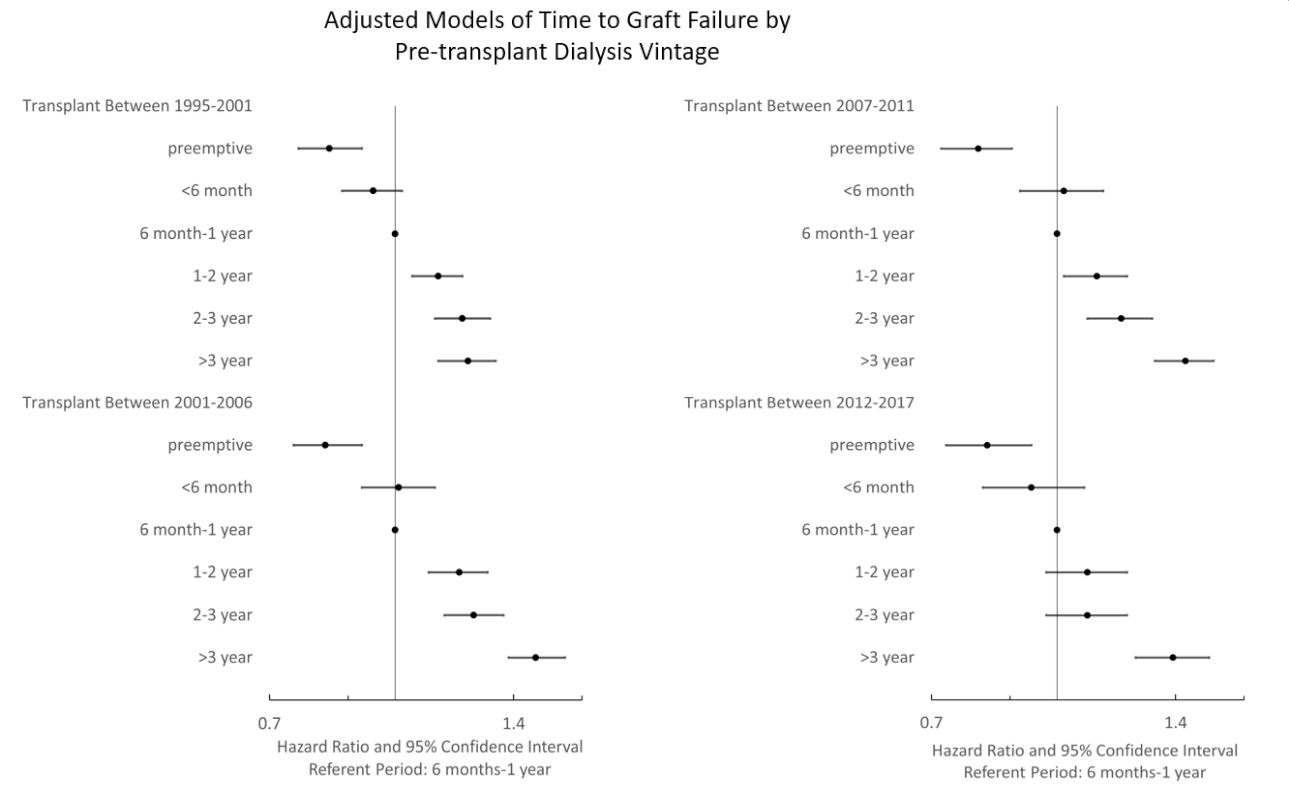Trends in Time to Graft Loss by Dialysis Vintage
Stanford University, Palo Alto, CA
Meeting: 2020 American Transplant Congress
Abstract number: 451
Keywords: Graft failure, Kidney transplantation, Mortality, Waiting lists
Session Information
Session Name: Kidney Complications: Immune Mediated Late Graft Failure
Session Type: Oral Abstract Session
Date: Saturday, May 30, 2020
Session Time: 3:15pm-4:45pm
 Presentation Time: 3:39pm-3:51pm
Presentation Time: 3:39pm-3:51pm
Location: Virtual
*Purpose: Preemptive transplantation has been shown to be beneficial regarding all-cause graft failure compared to transplantation after dialysis initiation, and transplantation after a shorter time on dialysis (dialysis vintage) is better than after a longer dialysis vintage. Considering recent registry reports of improved dialysis-related mortality rates in the United States, we examined trends of graft loss by time on dialysis prior to kidney transplantation.
*Methods: Using the United States Renal Data System (USRDS) we performed a retrospective cohort study of adults over age 18 who required first renal replacement therapy between January 1, 1995 and July 31, 2017. We used an adjusted Cox model to examine the association between dialysis exposure prior to first transplantation (categorized as preemptive, less than six months, six months to one year, one to two years, two to three years, and greater than three years) and hazard of graft failure (graft loss or death) within three years of transplantation. Our model was adjusted for demographic factors, reported cause of end-stage kidney disease, BMI, panel reactive antibodies, diabetes status, coronary artery disease status, and peripheral vascular disease status. We organized patients into the following transplant year groupings: 1995-2001, 2002-2006, 2007-2011, and 2012-2017.
*Results: A total of 287,281 transplant recipients were studied and 40,370 had graft loss within 3 years. The hazard ratio for graft loss was lower for preemptive transplant recipients compared to those transplanted after six months to one year of dialysis (referent group) across all time periods, ranging from 0.80 (95% CI 0.72-0.88) for those transplanted between 2007-2011 to 0.83 (95% CI 0.76-0.9) for the 2012-2017 group (figure). Over time, there has been a decrease in the hazard of graft loss with dialysis vintage except for those with the longest pre-transplant dialysis time. For patients with first RRT between 2002-2006, the hazard ratio for those with two to three years of dialysis prior to transplant compared to the referent group was 1.21 (95% CI 1.12-1.31). For the 2012-2017 group the hazard ratio was 1.09 (95% CI 0.97-1.22) (figure).
*Conclusions: Although preemptive transplantation offered the best graft survival across the study period, in the more recent era the negative association between longer, but not longest, duration of pre-transplant dialysis and post-transplant graft survival appears to have diminished.
To cite this abstract in AMA style:
Ahearn P, Lenihan C, Scandling J. Trends in Time to Graft Loss by Dialysis Vintage [abstract]. Am J Transplant. 2020; 20 (suppl 3). https://atcmeetingabstracts.com/abstract/trends-in-time-to-graft-loss-by-dialysis-vintage/. Accessed December 15, 2025.« Back to 2020 American Transplant Congress

